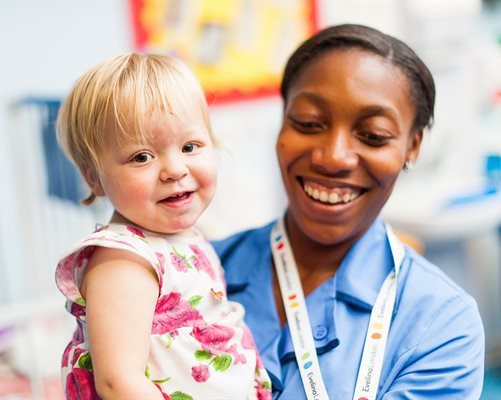Babies to benefit from new milk allergy guidance
Posted on Wednesday 23rd August 2017

Nursing holding a baby girl.
New guidelines are set to help thousands of babies around the world who are allergic to cow’s milk.
The international advice is a collaboration between leading children’s allergy experts from every continent, led by an allergy specialist at Evelina London alongside other UK experts.
The international milk allergy in primary care (iMAP) advice has today been published in the journal Clinical and Translational Allergy. It aims to help health professionals all over the world to diagnose non-IgE milk allergy, a type of milk allergy which causes a wide range of vague symptoms including eczema, reflux, colic and stomach problems. The symptoms are usually not obviously due to allergy, do not only appear immediately and can be caused by other conditions, making the allergy hard to spot.
Cow’s milk allergy is one of the most common allergies in children, affecting around 2 per cent of children under four, and the UK has the highest rates in Europe. Around half of babies with milk allergy have non-IgE or ‘delayed’ milk allergy.
Dr Adam Fox, Consultant Children’s Allergist at Evelina London Children’s Hospital and senior author of the new guidelines, said:
“The iMAP guidance can help primary care physicians to correctly diagnose, manage and follow up patients, alleviating their symptoms. For example, it explains which symptoms doctors should consider and the steps they should take if milk allergy is suspected. GPs may think that a patient can have an allergy test for milk but that only works for IgE milk allergy.
“We’re very proud to bring together experts from around the world to create this advice, which should have a big impact on children worldwide. Even though most infants grow out of milk allergy by age two or three, an early diagnosis means that instead of having a miserable baby their symptoms can be minimised which has a positive effect on the whole family.”
Lucy Wronka, 36 from Forest Hill in south east London, has two children with non-IgE milk allergies, George, aged four, and Iris, aged two.
Lucy, a professional development manager, said: “George’s problems started when he was two weeks old. He was formula fed because I was unable to breastfeed. He was sickly, unsettled, didn’t sleep and had colic and reflux.
“Over the next few months I went back and forth to my GP as George’s symptoms got worse. Looking back, his symptoms were all classic signs of milk allergy but they weren’t picked up on.”
Then Lucy met a friend who worked at Guy’s and St Thomas’ who advised that George should be referred to the allergy team.
Lucy said: “A month later we saw a consultant who was fantastic and prescribed hypoallergenic formula, an alternative to cow’s milk. Within a week it was like we had a different child. George was much happier, his skin improved, his cradle cap disappeared and he started sleeping. His symptoms virtually disappeared overnight. I don’t know what we would have done if we hadn’t seen the team.”
When Iris was born she was also fed with cow’s milk formula and within 24 hours was covered in a rash. Iris was soon given hypoallergenic formula which prevented her from getting the same symptoms.
Lucy added: “I think the new guidelines are brilliant. Anything that can highlight the condition and include an easy programme for doctors to implement in terms of diagnosis will really benefit a lot of children like George and Iris. They are both thriving now which is a testament to the care they received.”
Health professionals can also access the guidelines on Allergy UK’s website.